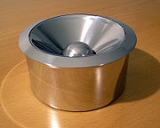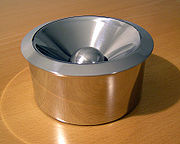
Marianne Brandt
Encyclopedia

Germany
Germany , officially the Federal Republic of Germany , is a federal parliamentary republic in Europe. The country consists of 16 states while the capital and largest city is Berlin. Germany covers an area of 357,021 km2 and has a largely temperate seasonal climate...
painter
Painting
Painting is the practice of applying paint, pigment, color or other medium to a surface . The application of the medium is commonly applied to the base with a brush but other objects can be used. In art, the term painting describes both the act and the result of the action. However, painting is...
, sculptor
Sculpture
Sculpture is three-dimensional artwork created by shaping or combining hard materials—typically stone such as marble—or metal, glass, or wood. Softer materials can also be used, such as clay, textiles, plastics, polymers and softer metals...
, photographer and designer
Designer
A designer is a person who designs. More formally, a designer is an agent that "specifies the structural properties of a design object". In practice, anyone who creates tangible or intangible objects, such as consumer products, processes, laws, games and graphics, is referred to as a...
who studied at the Bauhaus
Bauhaus
', commonly known simply as Bauhaus, was a school in Germany that combined crafts and the fine arts, and was famous for the approach to design that it publicized and taught. It operated from 1919 to 1933. At that time the German term stood for "School of Building".The Bauhaus school was founded by...
school and became head of the metal workshop in 1928. Today, Brandt's designs for household objects such as lamps, ashtrays and teapots are considered the harbinger of modern industrial design.
Biography
Brandt was born in ChemnitzChemnitz
Chemnitz is the third-largest city of the Free State of Saxony, Germany. Chemnitz is an independent city which is not part of any county and seat of the government region Direktionsbezirk Chemnitz. Located in the northern foothills of the Ore Mountains, it is a part of the Saxon triangle...
as Marianne Liebe. In 1919 she married the Norwegian painter Erik Brandt, with whom she traveled in Norway and France. She trained as a painter before joining the Weimar
Weimar
Weimar is a city in Germany famous for its cultural heritage. It is located in the federal state of Thuringia , north of the Thüringer Wald, east of Erfurt, and southwest of Halle and Leipzig. Its current population is approximately 65,000. The oldest record of the city dates from the year 899...
Bauhaus in 1923. There she became a student of Hungarian modernist theorist and designer László Moholy-Nagy
László Moholy-Nagy
László Moholy-Nagy was a Hungarian painter and photographer as well as professor in the Bauhaus school. He was highly influenced by constructivism and a strong advocate of the integration of technology and industry into the arts.-Early life:...
in the metal workshop. She quickly rose to the position of workshop assistant and succeeded Moholy as the workshop's director in 1928, serving in the post for one year and negotiating some of the most important Bauhaus contracts for collaborations with industry. These contracts for the production of lights and other metal workshop designs were a rare example of one of the workshops helping to fund the school. After leaving the Bauhaus for Berlin in 1929, Brandt worked for Walter Gropius
Walter Gropius
Walter Adolph Georg Gropius was a German architect and founder of the Bauhaus School who, along with Ludwig Mies van der Rohe and Le Corbusier, is widely regarded as one of the pioneering masters of modern architecture....
in his Berlin studio. She subsequently became the head of metal design at the Ruppel firm in Gotha
Gotha (town)
Gotha is a town in Thuringia, within the central core of Germany. It is the capital of the district of Gotha.- History :The town has existed at least since the 8th century, when it was mentioned in a document signed by Charlemagne as Villa Gotaha . Its importance derives from having been chosen in...
, where she remained until losing her job in the midst of the ongoing financial depression in 1932.
During the period of National Socialism in Germany, Brandt attempted to find work outside of the country, but family responsibilities called her back to Chemnitz. She was unable to find steady work throughout the period of the Third Reich. In 1939 she did become a member of the "Reichskulturkammer
Reichskulturkammer
The Reichskulturkammer was an institution of Nazi Germany. It was established by law on 22 September 1933 in the course of the Gleichschaltung process at the instigation of Reich Minister Joseph Goebbels as a professional organization of all German creative artists...
," the official Nazi
Nazism
Nazism, the common short form name of National Socialism was the ideology and practice of the Nazi Party and of Nazi Germany...
organization of artists, in order to obtain a few art supplies, which had otherwise been forbidden to her. However, Brandt was never a member of the National Socialist Party. After many years of living apart, she and Erik Brandt officially divorced in 1935.
Brandt died in Kirchberg, Saxony
Kirchberg, Saxony
Kirchberg is a town in the Zwickau district, in the Free State of Saxony, Germany. It is situated on the western end of the Ore Mountains, 11 km south of Zwickau....
at the age of 89. While the Bauhaus was generally reviled as "decadent" during much of the GDR period, by the end of her life Brandt had a loyal group of students from her many years as a teacher of design.
Work
Brandt's designs for metal ashtrays, tea and coffee services, lamps and other household objects are now recognized as among the best of the WeimarWeimar
Weimar is a city in Germany famous for its cultural heritage. It is located in the federal state of Thuringia , north of the Thüringer Wald, east of Erfurt, and southwest of Halle and Leipzig. Its current population is approximately 65,000. The oldest record of the city dates from the year 899...
and Dessau
Dessau
Dessau is a town in Germany on the junction of the rivers Mulde and Elbe, in the Bundesland of Saxony-Anhalt. Since 1 July 2007, it is part of the merged town Dessau-Roßlau. Population of Dessau proper: 77,973 .-Geography:...
Bauhaus. Further, they were among the few Bauhaus designs to be mass-produced during the interwar period, and several of them are currently available as reproductions. In an auction in December 2007, one of her teapots —the Model No. MT49 tea infuser— was sold for a record-breaking $361,000.
Beginning in 1926, Brandt also produced a body of photomontage work, though all but a few were not publicly known until the 1970s after she had abandoned the Bauhaus style and was living in Communist East Germany. The photomontages came to public attention after Bauhaus historian Eckhard Neumann solicited the early experiments, stimulated by resurgent interest in modernist experiment in the West. These photomontages often focus on the complex situation of women in the interwar period, a time when they enjoyed new freedoms in work, fashion and sexuality, yet frequently experienced traditional prejudices. Brandt's montage works were subject of the touring exhibition entitled "Tempo, Tempo! The Bauhaus Photomontages of Marianne Brandt," organized by Elizabeth Otto, which appeared at the Bauhaus Archive in Berlin, Harvard's Busch-Reisinger Museum
Busch-Reisinger Museum
The Busch-Reisinger Museum, opened to the public in 1903, is one of two museums in North America dedicated to the study of art from the German-speaking countries of Europe. The other museum is the Neue Galerie, located in New York City. The Busch-Reisinger joins the Fogg Museum and the Arthur M...
and the International Center of Photography
International Center of Photography
The International Center of Photography is a photography museum, school, and research center in Midtown Manhattan in New York City, United States...
in New York from 2005 to 2006. Otto's catalogue of the same name explores these works and Brandt's life.
Brandt is also remembered as a pioneering photographer. She created experimental still-life compositions, but it is her series of self portraits which are particularly striking. These often represent her as a strong and independent New Woman
New Woman
The New Woman was a feminist ideal that emerged in the late 19th century. The New Woman pushed the limits set by male-dominated society, especially as modeled in the plays of Norwegian Henrik Ibsen . "The New Woman sprang fully armed from Ibsen's brain," according to a joke by Max Beerbohm...
of the Bauhaus; other examples show her face and body distorted across the curved and mirrored surfaces of metal balls, creating a blended image of herself and her primary medium at the Bauhaus.
External links
- http://www.mastersofmodernism.com/?page=Lighting&sp=cpl&item=8
- http://www.mastersofmodernism.com/?page=Silver&sp=tea&item=7 Life and work of Marianne Brandt International Marianne Brandt Contest "Down Tempo" by Ben Davis, Artnet Magazine

